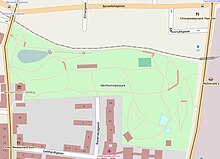Wertheimstein Park
The Wertheimsteinpark is a 62,500 m² park in the Vienna district of Oberdöbling on a natural slope towards the Danube Canal .
The park
The park's relief is highly structured. It is located east of Döblinger Hauptstraße and drops steeply to Heiligenstädter Straße (next to the Danube Canal) and to the suburb line , or to the Krottenbachtal. The Krottenbach was vaulted between 1893 and 1930 from Salmannsdorf to the Danube Canal. The last remnant is a small pond in the park.
The park is home to many old and exotic plants. In one part there is a garden for the blind. In addition to the memorial stone for the founder, there is also a bust of the writer Ferdinand von Saar , a long-time friend of the Wertheimstein family, erected in 1914 and designed by Franz Seifert , a monument erected in 1924 for the poet Franz Keim and a bust by Julius Schlegel erected in 1975 , the savior of Montecassino's art treasures .
history
In 1833 the textile manufacturer Rudolf von Arthaber (1795–1867) acquired the Tullner Hof with some reason. In the years 1834/35 he had the country house, later called Villa Wertheimstein , built and a private garden laid out. At the same time, he had the first palm and greenhouse of middle-class provenance built in Austria, which no longer exists today. Later he bought the adjoining Camaldolese courtyard and expanded the park. The art-loving arthaber's private picture gallery housed in the villa was at times the largest of its kind in Vienna . The guests of the house included the finest social circles in the royal seat as well as members of the imperial family.
After Arthaber's death, the picture gallery was auctioned and Leopold Ritter von Wertheimstein (1801-1883) and his wife Josephine (1820-1894) bought the villa and the grounds from their heirs. Wertheimstein was a banker, finance advisor and consul and confidante of the Rothschilds . He was a big bourgeois who also spent a lot of money on art and literature. In the family's literary salon , Salon Wertheimstein , some famous people were permanent guests and it developed into an intellectual, liberal center of Vienna. After her mother's death, the salon was continued by her daughter Franziska von Wertheimstein (1844–1907). The poet Eduard von Bauernfeld died on August 9, 1890 as a guest of the owner in the former Camaldolese farm . Franziska bequeathed the villa and the park to the City of Vienna in a will with the stipulation that the park must always be preserved as a public green area.
The park was opened to the public on June 20, 1908, and the library was opened on July 3, 1912. Since 1912 there has been a Bauernfeld room and a Saar room in the villa. In the period 1938–1945 the park was called " Dietrich-Eckart -Park". In 1959, the first blind garden in Central Europe was built in the park, based on models in Brighton and Edinburgh . The Döbling District Museum has been housed in the villa since 1964 , with a viticulture museum in the neighboring building. A lizard biotope was created in 1992 on the retaining wall on Heiligenstädter Strasse.
In the speaking piece Trude die Teufelstaube on the 1983 album DÖF by Deutsch-Österreichischen Feingefühls , the big, diabolical pigeon monster in Vienna chooses this park "on its fatal foray for food" through Europe and eats the pigeon feeder Aloisia K. in the evening twilight .
In the story , the cheap-eaters of Thomas Bernhard , the park plays a prominent role as the place "ideal [r] natural conditions" in which the protagonist Koller, "all of a sudden instead as already habitually to the old ash to the old oak tree" as to a turning point in his Life experiences or performs.
Monuments in the Wertheimstein Park
The inscription on the memorial for the founder reads: “ Franziska von Wertheimstein , died on January 19, 1907, daughter of Mr. Leopold Ritter von Wertheimstein and Mrs. Josefine von Wertheimstein, née Gomperz, owned this park under the name Wertheimstein-Park of the municipality of Vienna Dedicated for public use for eternity by testamentary disposition. "
literature
- Peter Autengruber : Parks and Gardens in Vienna . Promedia, Vienna 2008, ISBN 978-3-85371-281-8 .
- Gertraud Koszteczky: The history of Viennese green spaces in connection with the social change of their users . Vienna 2007, OCLC 845370014 , dissertation University of Vienna 2007, 284 pages, online version , PDF, free of charge, 284 pages, 3976 KB.
- Felix Czeike (Ed.): Historisches Lexikon Wien . Volume 5, Kremayr & Scheriau, Vienna 1997, ISBN 3-218-00547-7 , p. 619.
Web links
- Wertheimstein Park. Website of the City of Vienna.
- Siegfried Weyr: Wertheimsteinpark. From the manor garden to the little man's park. ( Memento from January 14, 2013 in the web archive archive.today )
Individual evidence
- ↑ a b c d e Felix Czeike (Ed.): Das Große Groner Wien Lexikon. Fritz Molden Verlag, 1974, ISBN 3-217-00293-8 , p. 839, “Wertheimsteinvilla”.
- ↑ Gertraud Koszteczky: The history of the Viennese green spaces in connection with the social change of their users. (PDF; 4.1 MB), dissertation at the University of Vienna, 2007, p. 68.
- ^ Josephine von Wertheimstein. ( Memento of September 29, 2007 in the Internet Archive ) Literature in Viennese Modernism.
- ↑ WERTHEIMSTEIN, Josephine von, née GOMPERZ. Lithes (literature and theater sociology), University of Graz, project "Letters to Anatasius Grün".
- ^ Franziska von Wertheimstein. ( Memento of July 4, 2009 in the Internet Archive ) Literature in Viennese Modernism.
- ^ Margit Grassinger: Parks and Gardens in Vienna. Landscape architecture between tradition and urban expansion programs. ( Memento from September 29, 2007 in the Internet Archive ) In: Landschaftsarchitekten. 4/2006, Association magazine of the Federation of German Landscape Architects .
- ↑ Wertheimstein Park. History. Vienna City Garden Office.
Coordinates: 48 ° 14 '35.7 " N , 16 ° 21' 29.9" E








